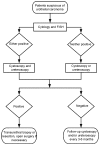Prospective evaluation of fluorescence in situ hybridization for diagnosing urothelial carcinoma
- PMID: 28529600
- PMCID: PMC5431676
- DOI: 10.3892/ol.2017.5926
Prospective evaluation of fluorescence in situ hybridization for diagnosing urothelial carcinoma
Abstract
Urothelial carcinoma (UC) is the most common type of cancer of the bladder and upper urinary tract, and is characterized by a high risk of recurrence and progression. Urine fluorescence in situ hybridization (FISH) is a technique that detects genetic aberrations in exfoliated cells in the urine, with specific probes for chromosomes 3, 7 and 17 and the p16 gene. To evaluate the diagnostic value of FISH in UC, 119 patients from November 2010 to June 2012 with suspected UC were recruited into a prospective, cross-sectional study and were followed up for 12-30 months. These patients received voided urine cytology and FISH tests, and underwent cystoscopy and/or ureteroscopy as a reference standard. The final diagnoses confirmed 73 patients with UC, located in the bladder, upper urinary tracts or the two. The sensitivity of FISH for detecting UC was superior to cytology, irrespective of tumor grade and stage: Overall, 80.8 vs. 32.9% (P<0.001); low grade, 75.8 vs. 12.1% (P<0.001); high grade, 85 vs. 50% (P<0.005); non-muscle-invasive, 81.1 vs. 28.3% (P<0.001) and muscle-invasive, 80 vs. 45% (P<0.05), respectively. The specificities of the two tests were similar; overall, the specificity was 89.1% for cytology vs. 100% for FISH, and no significant difference was observed between the methods. Notably, FISH exhibited 100% sensitivity for cytologically non-diagnostic UC, but 33.3% specificity. In conclusion, FISH is a reliable and non-invasive diagnostic tool for bladder and upper urinary tract UC, particularly in patients with low-grade or early stage tumors.
Keywords: bladder cancer; cytology; diagnosis; fluorescence in situ hybridization; sensitivity; specificity; transitional cell carcinoma; urothelial carcinoma.
Figures


Similar articles
-
A comprehensive comparison of fluorescence in situ hybridization and cytology for the detection of upper urinary tract urothelial carcinoma: A systematic review and meta-analysis.Medicine (Baltimore). 2018 Dec;97(52):e13859. doi: 10.1097/MD.0000000000013859. Medicine (Baltimore). 2018. PMID: 30593189 Free PMC article.
-
[Numerical aberrations of chromosomes 11 and 17 detected by fish--fluorescence in situ hybridization combined with cytology in exfoliated cells from voided urine in patients with urothelial carcinoma of the bladder].Harefuah. 2007 Dec;146(12):914-9, 1000. Harefuah. 2007. PMID: 18254439 Hebrew.
-
[Clinical value of fluorescence in situ hybridization positive of exfoliated urothelial cells in urothelial carcinoma].Beijing Da Xue Xue Bao Yi Xue Ban. 2017 Aug 18;49(4):585-589. Beijing Da Xue Xue Bao Yi Xue Ban. 2017. PMID: 28816270 Chinese.
-
The Clinical Application of Fluorescence in Situ Hybridization in Diagnosing Urothelial Carcinoma.Clin Lab. 2016 Oct 1;62(10):2001-2009. doi: 10.7754/Clin.Lab.2016.160323. Clin Lab. 2016. PMID: 28164542
-
UroVysion fluorescence in situ hybridization in urothelial carcinoma: a narrative review and future perspectives.Transl Androl Urol. 2021 Apr;10(4):1908-1917. doi: 10.21037/tau-20-1207. Transl Androl Urol. 2021. PMID: 33968678 Free PMC article. Review.
Cited by
-
Surveillance of non-muscle invasive bladder cancer using fluorescence in situ hybridization: Protocol for a systematic review and meta-analysis.Medicine (Baltimore). 2019 Feb;98(7):e14573. doi: 10.1097/MD.0000000000014573. Medicine (Baltimore). 2019. PMID: 30762807 Free PMC article.
-
Urinary expression of genes involved in DNA methylation and histone modification for diagnosis of bladder cancer in patients with asymptomatic microscopic haematuria.Oncol Lett. 2019 Jul;18(1):57-62. doi: 10.3892/ol.2019.10330. Epub 2019 May 7. Oncol Lett. 2019. PMID: 31289472 Free PMC article.
-
Second-line treatment strategy for urothelial cancer patients who progress or are unfit for cisplatin therapy: a network meta-analysis.BMC Urol. 2019 Dec 2;19(1):125. doi: 10.1186/s12894-019-0560-7. BMC Urol. 2019. PMID: 31791304 Free PMC article.
-
A comprehensive comparison of fluorescence in situ hybridization and cytology for the detection of upper urinary tract urothelial carcinoma: A systematic review and meta-analysis.Medicine (Baltimore). 2018 Dec;97(52):e13859. doi: 10.1097/MD.0000000000013859. Medicine (Baltimore). 2018. PMID: 30593189 Free PMC article.
-
Auxiliary diagnostic value of p16 amplification combined with the detection of heterozygous and homozygous loss for urothelial carcinoma.Oncol Lett. 2018 May;15(5):6533-6540. doi: 10.3892/ol.2018.8137. Epub 2018 Mar 1. Oncol Lett. 2018. PMID: 29731855 Free PMC article.
References
-
- Ries LAG, Young JL, Keel GE, Eisner MP, Lin YD, Horner MJ, editors. National Cancer Institute, SEER Program. Bethesda, MD: 2007. SEER survival monograph: Cancer survival among adults: U.S. seer program, 1988–2001, patient and tumor characteristics. NIH Pub. No. 07-6215.
LinkOut - more resources
Full Text Sources
Other Literature Sources
